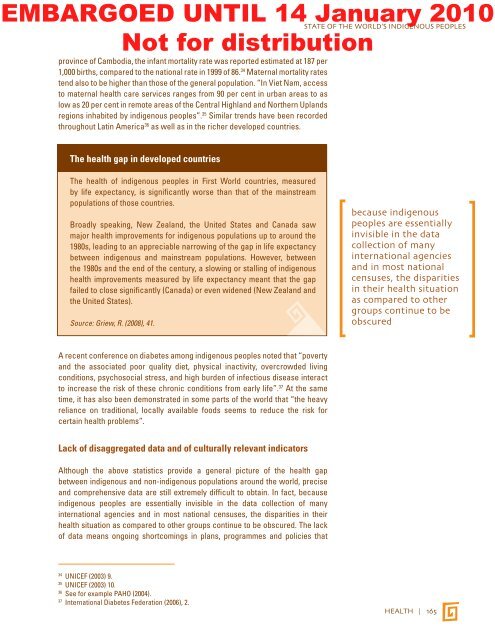EMBARGOED UNTIL 14 January 2010<strong>STATE</strong> <strong>OF</strong> <strong>THE</strong> WORLD’S INDIGENOUS PEOPLESNot for distributionprovince of Cambodia, the infant mortality rate was reported estimated at 187 per1,000 births, compared to the national rate in 1999 of 86. 34 Maternal mortality ratestend also to be higher than those of the general population. “In Viet Nam, accessto maternal health care services ranges from 90 per cent in urban areas to aslow as 20 per cent in remote areas of the Central Highland and Northern Uplandsregions inhabited by indigenous peoples”. 35 Similar trends have been recordedthroughout Latin America 36 as well as in the richer developed countries.The health gap in developed countriesThe health of indigenous peoples in First World countries, measuredby life expectancy, is significantly worse than that of the mainstreampopulations of those countries.Broadly speaking, New Zealand, the United States and Canada sawmajor health improvements for indigenous populations up to around the1980s, leading to an appreciable narrowing of the gap in life expectancybetween indigenous and mainstream populations. However, betweenthe 1980s and the end of the century, a slowing or stalling of indigenoushealth improvements measured by life expectancy meant that the gapfailed to close significantly (Canada) or even widened (New Zealand andthe United States).Source: Griew, R. (2008), 41.because indigenouspeoples are essentiallyinvisible in the datacollection of manyinternational agenciesand in most nationalcensuses, the disparitiesin their health situationas compared to othergroups continue to beobscuredA recent conference on diabetes among indigenous peoples noted that “povertyand the associated poor quality diet, physical inactivity, overcrowded livingconditions, psychosocial stress, and high burden of infectious disease interactto increase the risk of these chronic conditions from early life”. 37 At the sametime, it has also been demonstrated in some parts of the world that “the heavyreliance on traditional, locally available foods seems to reduce the risk forcertain health problems”.Lack of disaggregated data and of culturally relevant indicatorsAlthough the above statistics provide a general picture of the health gapbetween indigenous and non-indigenous populations around the world, preciseand comprehensive data are still extremely difficult to obtain. In fact, becauseindigenous peoples are essentially invisible in the data collection of manyinternational agencies and in most national censuses, the disparities in theirhealth situation as compared to other groups continue to be obscured. The lackof data means ongoing shortcomings in plans, programmes and policies that34UNICEF (2003) 9.35UNICEF (2003) 10.36See for example PAHO (2004).37International Diabetes Federation (2006), 2.HEALTH | 165
EMBARGOED UNTIL 14 January 2010<strong>STATE</strong> <strong>OF</strong> <strong>THE</strong> WORLD’S INDIGENOUS PEOPLESNot for distributionseek to improve global health, including efforts to achieve the MDGs, which are based on averages instead ofdisaggregated data. Similarly, even when indigenous peoples appear in health data, they are often conceived of asa percentage of a national population, which UNICEF has noted “can be misleading in as much as the distributionof certain indigenous peoples does not correspond to national boundaries. As an illustration, the Quechua inSouth America are found in significant numbers in six countries and the Fulani of West Africa extend across eightcountries”. 38 PAHO has thus continually stated that “the lack of vital statistics or breakdown by ethnic groups,gender, and age makes the generation of policies and managerial processes based on evidence more difficult,which, in turn, jeopardizes the formulation of priorities and appropriate monitoring and evaluation systems forindigenous populations”. 39In order to design public policies aimed at improving the health situation and related conditions of poverty anddiscrimination faced by indigenous peoples, it is necessary to collect disaggregated data, to develop culturallyrelevant indicators of health and well-being rooted in the world views of indigenous peoples, and to advancemethodologies for conducting research into indigenous peoples. Moreover, indigenous peoples must have fulland effective participation and take leadership roles in the collection, processing, reporting and use of informationthat guides decision-making in health policies and programmes.In the international arena, and especially in the United Nations system, there has been increased recognition ofthis need for improved data collection.Aboriginal health indicators in CanadaThe Assembly of First Nations (AFN) represents over 630 communities in Canada. Since its charter wasadopted in 1985, it has lobbied for the rights of indigenous peoples, setting policy objectives, conductingresearch, and negotiating with the state on issues such as treaty rights, economic development, cultureand language, education, health, housing, justice, and environment.AFN’s research and policy development on the health of indigenous peoples complements the First NationsRegional Longitudinal Health Survey (RHS), which was initiated in 1997 as the most extensive nationalhealth survey on indigenous peoples and the only national research initiative controlled by indigenouspeoples. It was stewarded by the National Aboriginal Health Organization and governed by the FirstNations Information Governance Committee, comprising First Nations regional health coordinators fromten regions across Canada. The RHS was based on the principles of Ownership, Control, Access andPossession (OCAP) to ensure self-determination over the data collection process. The survey used theframework of holistic health and gathered information on areas such as demographics, languages, cultureand religion, education, employment, water quality, food and nutrition, community development, housing,physical activity, health conditions, HIV/AIDS, diabetes, drug and alcohol use, and suicide attempts.In 2005, the National Chief of the AFN proposed that all governments in Canada work toward “Closing theGap” between indigenous and non-indigenous populations in health and well-being. AFN thus deviseda “Closing the Gap Reporting Framework” of indicators, and a First Nations Holistic Policy and PlanningModel, which guides policy interventions and the development of performance indicators.AFN’s indicators of well-being are linked to each of the core issues in the holistic health model, which isbased on the following principles:38UNICEF (2003), Innocenti Digest, No.11, 8.39PAHO (2006), 3.166 | CHAPTER V
















